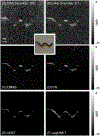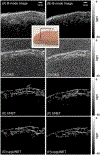Deep-Learning Image Reconstruction for Real-Time Photoacoustic System
- PMID: 32396076
- PMCID: PMC8594135
- DOI: 10.1109/TMI.2020.2993835
Deep-Learning Image Reconstruction for Real-Time Photoacoustic System
Abstract
Recent advances in photoacoustic (PA) imaging have enabled detailed images of microvascular structure and quantitative measurement of blood oxygenation or perfusion. Standard reconstruction methods for PA imaging are based on solving an inverse problem using appropriate signal and system models. For handheld scanners, however, the ill-posed conditions of limited detection view and bandwidth yield low image contrast and severe structure loss in most instances. In this paper, we propose a practical reconstruction method based on a deep convolutional neural network (CNN) to overcome those problems. It is designed for real-time clinical applications and trained by large-scale synthetic data mimicking typical microvessel networks. Experimental results using synthetic and real datasets confirm that the deep-learning approach provides superior reconstructions compared to conventional methods.
Figures










Similar articles
-
Hybrid Neural Network for Photoacoustic Imaging Reconstruction.Annu Int Conf IEEE Eng Med Biol Soc. 2019 Jul;2019:6367-6370. doi: 10.1109/EMBC.2019.8857019. Annu Int Conf IEEE Eng Med Biol Soc. 2019. PMID: 31947299
-
Sensor-to-Image Based Neural Networks: A Reliable Reconstruction Method for Diffuse Optical Imaging of High-Scattering Media.Sensors (Basel). 2022 Nov 23;22(23):9096. doi: 10.3390/s22239096. Sensors (Basel). 2022. PMID: 36501794 Free PMC article.
-
Anatomically aided PET image reconstruction using deep neural networks.Med Phys. 2021 Sep;48(9):5244-5258. doi: 10.1002/mp.15051. Epub 2021 Jul 28. Med Phys. 2021. PMID: 34129690 Free PMC article.
-
A review of advances in imaging methodology in fluorescence molecular tomography.Phys Med Biol. 2022 May 2;67(10). doi: 10.1088/1361-6560/ac5ce7. Phys Med Biol. 2022. PMID: 35276686 Review.
-
Sounding out the hidden data: A concise review of deep learning in photoacoustic imaging.Exp Biol Med (Maywood). 2021 Jun;246(12):1355-1367. doi: 10.1177/15353702211000310. Epub 2021 Mar 27. Exp Biol Med (Maywood). 2021. PMID: 33779342 Free PMC article. Review.
Cited by
-
Sparse-view reconstruction for photoacoustic tomography combining diffusion model with model-based iteration.Photoacoustics. 2023 Sep 16;33:100558. doi: 10.1016/j.pacs.2023.100558. eCollection 2023 Oct. Photoacoustics. 2023. PMID: 38021282 Free PMC article.
-
Enhancement of in vivo cardiac photoacoustic signal specificity using spatiotemporal singular value decomposition.J Biomed Opt. 2021 Apr;26(4):046001. doi: 10.1117/1.JBO.26.4.046001. J Biomed Opt. 2021. PMID: 33876591 Free PMC article.
-
Review on ultrasound-guided photoacoustic imaging for complementary analyses of biological systems in vivo.Exp Biol Med (Maywood). 2023 May;248(9):762-774. doi: 10.1177/15353702231181341. Epub 2023 Jul 15. Exp Biol Med (Maywood). 2023. PMID: 37452700 Free PMC article. Review.
-
Approximating the uncertainty of deep learning reconstruction predictions in single-pixel imaging.Commun Eng. 2023;2:53. doi: 10.1038/s44172-023-00103-1. Epub 2023 Aug 1. Commun Eng. 2023. PMID: 38463559 Free PMC article.
-
Looking deep inside tissue with photoacoustic molecular probes: a review.J Biomed Opt. 2022 Jul;27(7):070901. doi: 10.1117/1.JBO.27.7.070901. Epub 2022 Jul 22. J Biomed Opt. 2022. PMID: 36451698 Free PMC article. Review.
References
-
- Szabo TL, Diagnostic ultrasound imaging: inside out. Academic Press, 2004.
Publication types
MeSH terms
Grants and funding
LinkOut - more resources
Full Text Sources
Other Literature Sources

